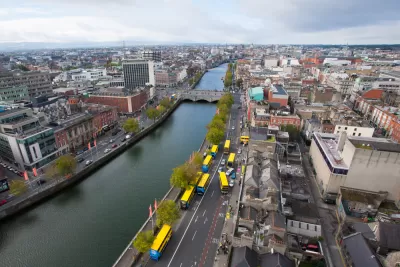Chuck Wolfe underscores the importance of a holistic view of urban places, referencing themes of common experience, aesthetics, feelings of happiness, safety, or security—a basic narrative of the city that often goes beyond first impressions.

Using the foil of a dramatic urban view that has remained unchanged in an evolving Seattle neighborhood, Wolfe suggests that the goals of good urbanism are often buried by jargon of the day.
Open a book, read only, say, page 77, and the prose may please the mind or heart, but the richness of the story may suffer. Why? Because the plot is still unclear.
Reading the city is no different, he notes, with reference to his linked slideshow of international, human-scale urban imagery, and to a colorful photograph of the view referenced above. He suggests that taking pause, and recalling context and any background story, is the first step towards achieving community, neighborhood, and a better place.
"Urban challenges often first appear as conflicts of ideology, habit or style, without nuance. Yet the irony of underlying commonality is great, and should not be lost," he notes, citing examples from Jerusalem, Seattle, and the recent writing of Charles Montgomery and Jaime Lerner.
Wolfe suggests greater emphasis on common foundations and common ground in discussions of urban affairs, urging "that any professional embracing urban policy, practice, and as a precursor to innovation...read... the entire book, the one that tells the important back stories, and sets a universal, human tone."
FULL STORY: Reading Cities, Cover to Cover, And Why

Planetizen Federal Action Tracker
A weekly monitor of how Trump’s orders and actions are impacting planners and planning in America.

Trump Administration Could Effectively End Housing Voucher Program
Federal officials are eyeing major cuts to the Section 8 program that helps millions of low-income households pay rent.

The 120 Year Old Tiny Home Villages That Sheltered San Francisco’s Earthquake Refugees
More than a century ago, San Francisco mobilized to house thousands of residents displaced by the 1906 earthquake. Could their strategy offer a model for the present?

Texas Bill Would Ban Road Diets, Congestion Pricing
A Texas state senator wants to prevent any discussion of congestion pricing and could suspend existing bike lane and sidewalk projects.

USDOT Threatens to Pull New York Highway Funding
The Trump administration wants the state to kill New York City’s congestion pricing program despite its demonstrated success.

LA’s Tree Emergency Goes Beyond Vandalism
After a vandal destroyed dozens of downtown LA trees, Mayor Karen Bass vowed to replace them. Days later, she slashed the city’s tree budget.
Urban Design for Planners 1: Software Tools
This six-course series explores essential urban design concepts using open source software and equips planners with the tools they need to participate fully in the urban design process.
Planning for Universal Design
Learn the tools for implementing Universal Design in planning regulations.
Ada County Highway District
Clanton & Associates, Inc.
Jessamine County Fiscal Court
Institute for Housing and Urban Development Studies (IHS)
City of Grandview
Harvard GSD Executive Education
Toledo-Lucas County Plan Commissions
Salt Lake City
NYU Wagner Graduate School of Public Service


























